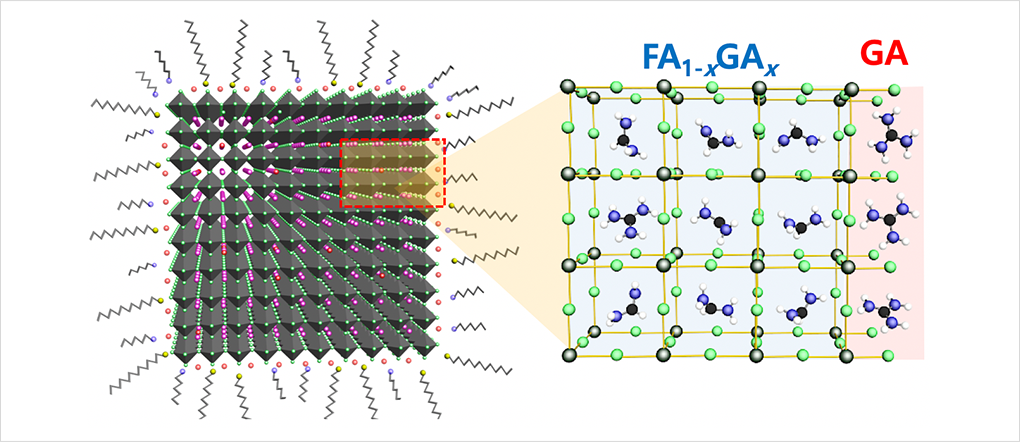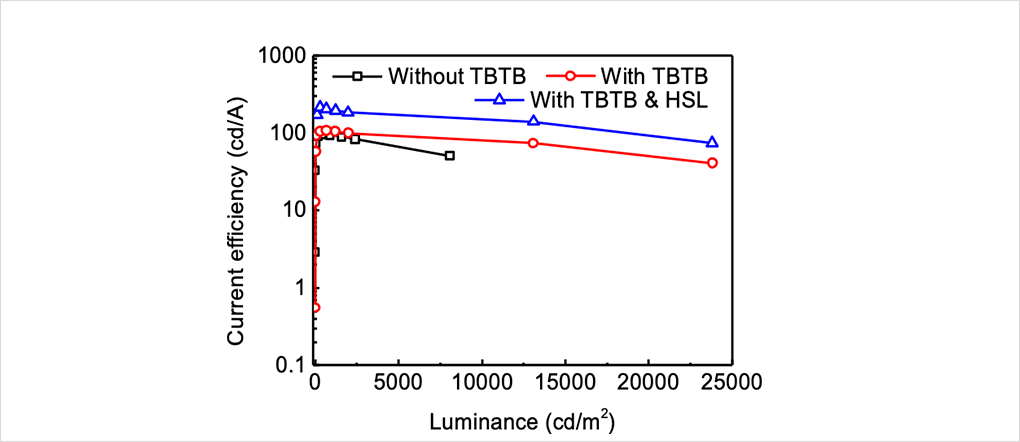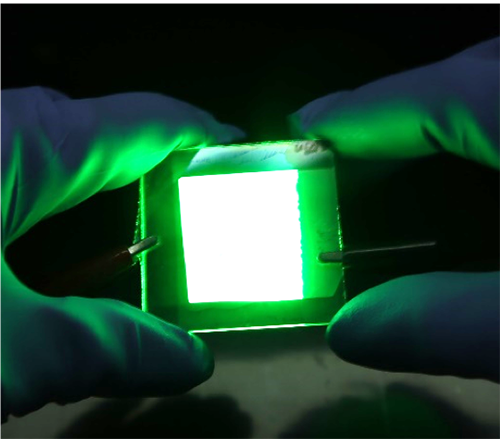Development of the composition and defect control methods for next-generation 'ultra-high-definition display' materials
Research results published in <Nature Photonics>, the world renown international journal

From left, Professor Tae-Woo Lee of Seoul National University, Professor Andrew M. Rappe of the University of Pennsylvania, Researchers Young-Hoon Kim and Sungjin Kim of the Seoul National University, and Dr. Arvin Kakekhani of the University of Pennsylvania
Professor Tae-Woo Lee of the Department of Materials Science and Engineering, Hybrid Materials at Seoul National University and Professor Andrew. M. Rappe of the University of Pennsylvania had their joint research team develop the world's highest efficiency light-emitting device using the metal halide perovskite. The research results were published in the world renown journal on January 4, 2021.
Perovskite consists of organic elements, metals and halogen elements. Along with having excellent color purity and being low in its material costs, it also has the advantage of being easily controllable in its colors. Since Professor Tae-Woo Lee's development of the world's first visible-region multicolored light emitting diode at room temperature in 2014, the perovskite light-emitting device has received the spotlight for being the next-generation display material to replace quantum dots and organic light emitters that are currently used in displays.
In 2015, Professor Tae-Woo Lee reported to the journal that the efficiency of perovskite light-emitting diodes reaches 8.53%. Within the next 5 years, Professor Tae-Woo Lee leads a greatly rapid development, increasing the efficiency of the light-emitting diode to 23.4%. This is an outstanding development rate in comparison to the quantum dot light-emitting diodes that took around 20 years to achieve a level of 20% external quantum efficiency since its first report. This rapid pace of development has proven that perovskite displays can be commercialized in the near future. In particular, perovskite emitters, being a high color purity luminescent material, are the only ones that satisfy the new color standard REC. 2020 among existing light emitters. The new color standard REC. 2020 offers a richer and more vivid images with a color domain that is approximately 40% larger than the current color standard (DCI-P3).
In order to meet the REC. 2020 color standard, it requires a Full Width at Half Maximum (FWHM) level of luminescence at 20 nm. However, this cannot be implemented with conventional organic light emitters (FWHM~50 nm), quantum dots (FWHM~30 nm) and only perovskite emitters with FWHM of ~20 nm can meet this. Therefore, it is expected to actively contribute to the development of Ultra-High-Definition Television (UHD-TV) display technology in the future.
Perovskite light emitters fundamentally are limited by low exciton binding energy. To overcome this, research has been conducted to spatially confine excitons by manufacturing them in the form of nanoparticles that are several nanometers (one-billionth of a meter) in size.
that took around 20 years to achieve a level of 20% external quantum efficiency since its first report. This rapid pace of development has proven that perovskite displays can be commercialized in the near future. In particular, perovskite emitters, being a high color purity luminescent material, are the only ones that satisfy the new color standard REC. 2020 among existing light emitters. The new color standard REC. 2020 offers a richer and more vivid images with a color domain that is approximately 40% larger than the current color standard (DCI-P3).
In order to meet the REC. 2020 color standard, it requires a Full Width at Half Maximum (FWHM) level of luminescence at 20 nm. However, this cannot be implemented with conventional organic light emitters (FWHM~50 nm), quantum dots (FWHM~30 nm) and only perovskite emitters with FWHM of ~20 nm can meet this. Therefore, it is expected to actively contribute to the development of Ultra-High-Definition Television (UHD-TV) display technology in the future.
Perovskite light emitters fundamentally are limited by low exciton binding energy. To overcome this, research has been conducted to spatially confine excitons by manufacturing them in the form of nanoparticles that are several nanometers (one-billionth of a meter) in size.
However, perovskite nanoparticles are small in size, resulting in many defects on the surface. Further, the surface ligands surrounding the nanoparticles easily fall off. When ligands fall off, more defects are formed. There need to be measures to effectively control this problem.
The research team led by Professor Tae-Woo Lee at Seoul National University proposed a strategy to introduce Guanidinium organic cations into conventional Formamidinium-based perovskite nanoparticles. The additive cations that were introduced control both the defects present inside and on the surface of nanoparticles, effectively confining the charge carriers inside the nanoparticles, achieving a high photoluminescence quantum efficiency (of more than 90%).
In addition, the joint research team introduced halide-based small molecule, 1,3,5-tris (bromomethyl)-2, 4,6-triethylbenzene (TBTB), to the top of the perovskite nanoparticle thin film to eliminate residual defects. This produced perovskite light-emitting diodes with the world's highest external quantum efficiency (23.4%) and current efficiency (108cd/A-1). This is the highest device efficiency ever reported among perovskite light-emitting diodes.
A team of researchers at the University of Pennsylvania, led by Professor Andrew M. Lappe of the Joint Research Team identified the cause of the increase in efficiency by calculating the Density Functional Theory (DFT). They theoretically identified the mechanism of how some of the introduced guanidinium cations are located inside the perovskite crystals, stabilizing the crystals while the rest are located on the particle surface to inhibit surface defect formation. Furthermore, the principle of TBTB eliminating residual defects was also identified.
"By controlling the defects of perovskite nanoparticles, we have proposed methods to dramatically improve the light-emitting efficiency of perovskite light-emitting diodes," said Professor Tae-Woo Lee. "The research is expected to not only suggest ways to increase the efficiency of perovskite light-emitting diodes, but will also greatly contribute to increasing the possibility of commercializing perovskite light-emitting diodes," he added.
For further information, please contact Prof. Tae-Woo Lee.






